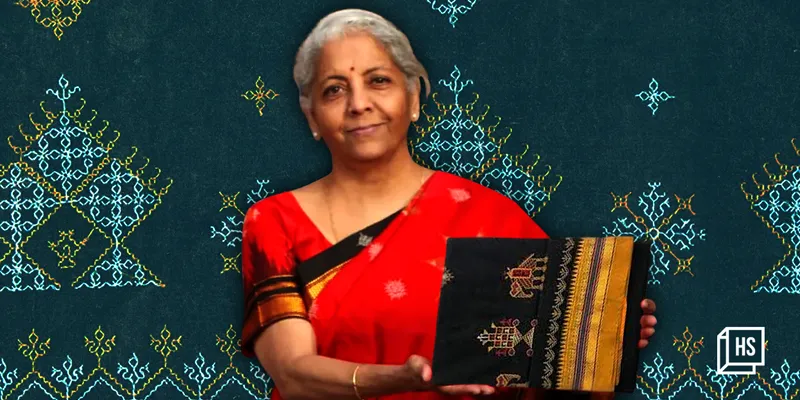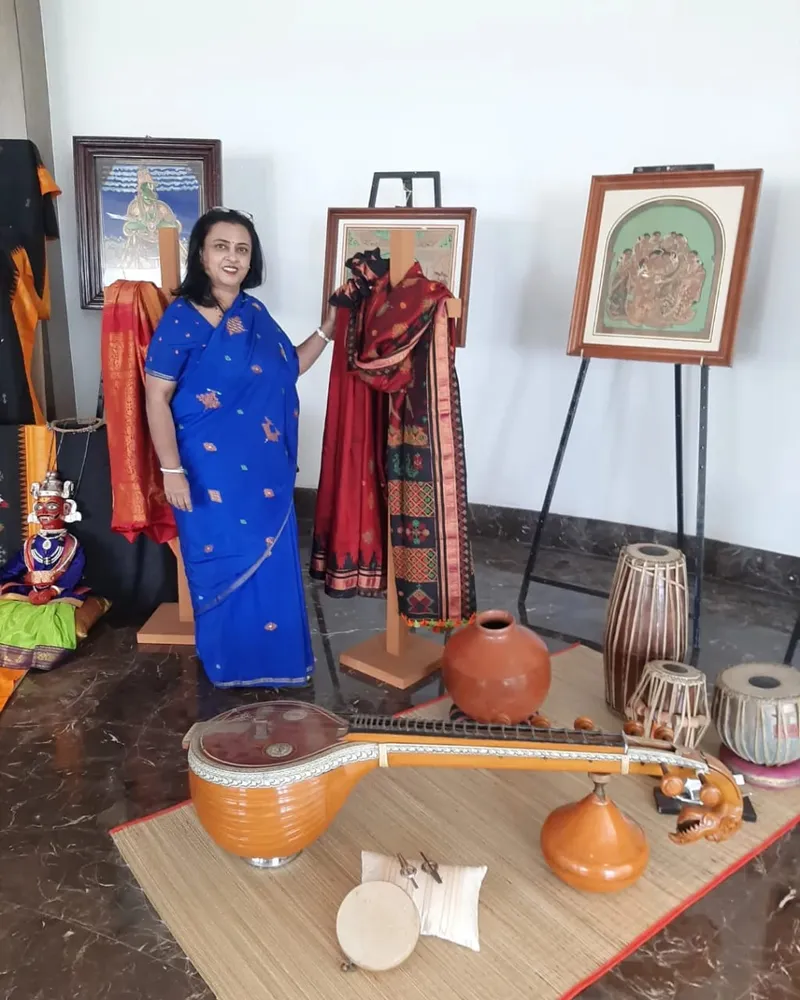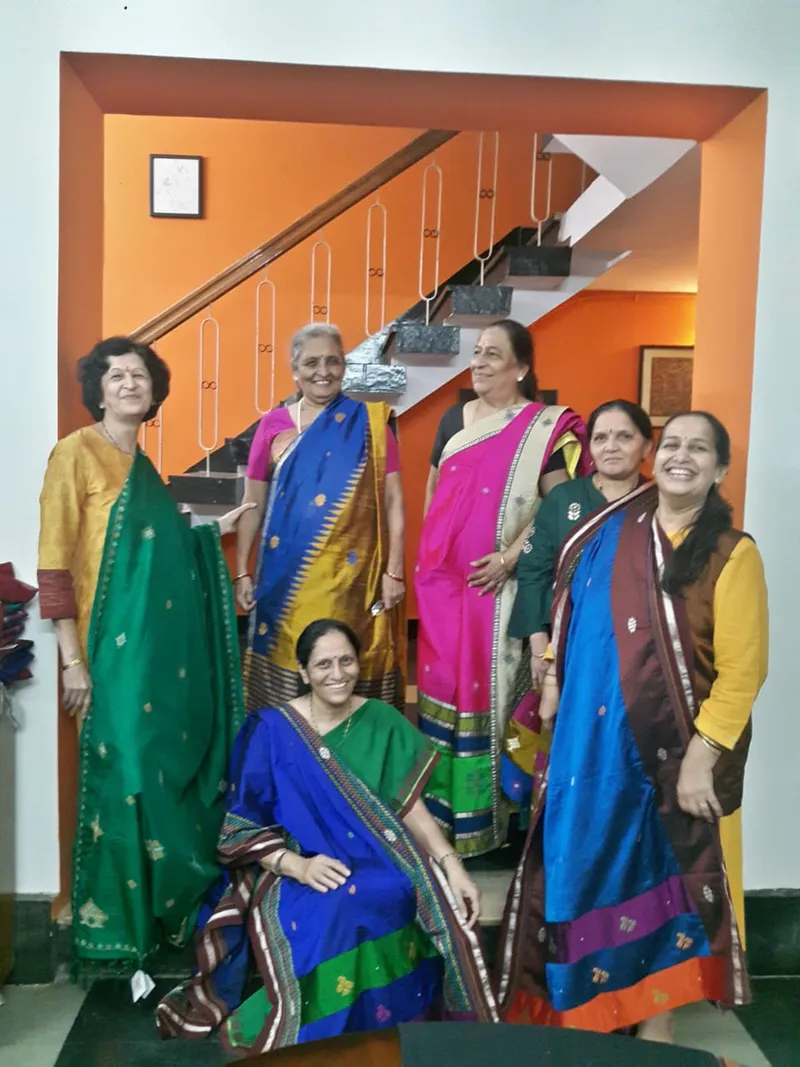Meet the entrepreneur who is keeping a 1,300-year-old art form alive
Here’s the story of Arati Hiremath, Founder of Artikrafts, who is empowering women artisans and working to keep Kasuti embroidery alive for the last 30 years.
Arati Hiremath received a pleasant surprise on Budget Day. She realised that the red silk saree worn by Finance Minister Nirmala Sitharaman was a product of her venture Artikrafts—a handicrafts company based in Dharwad, Karnataka, focused on Kasuti embroidery.
“It was a surreal moment for me. When we reached our store, we were swarmed with press and my phone was flooding with congratulatory messages. I cannot describe that feeling in words, but it all felt unreal,” Hiremath tells HerStory.

Nirmala Sitharaman wore Artikrafts' saree for the Budget session 2023
Weaving her destiny
Hiremath's story of reviving the languishing Kasuti art form started the year she got married and moved to Dharwad from Bengaluru in 1989.
Recalling the same, she says, a group of women doing Kasuti work came to her doorstep, asking her to help them get employment. To her surprise, she realised that it was the same group of women from the Kasuti training centre in Dharwad where her mother used to get her sarees made.
Because of her mother’s shared connection with those ladies and seeing the monetary challenges faced by the artisans, Hiremath decided to help them by connecting them with some shops in Bengaluru from where they could get regular orders.

Arati Hireamath
After a decade, Hiremath decided to scale this into her own venture. “My kids had grown up and I thought it is time to invest a little bit in the business,” she says.
She started showing the artisan’s work to her neighbours and in high-profile exhibitions, and slowly started getting a good response. The brand also diversified into making children’s wear, men’s wear, bags, and home décor products to cater to a broader audience.
“By the time it was 2002 and 2003, and people and the local administration admired our work and appreciated our potential. That time I felt that I was doing a good job,” she says.
After registering the company in 2003, Hiremath and a few friends started an NGO, SEMA (Society For Empowerment and Mobilisation Of Artisans). The organisation worked towards the skill development of local artisans. It also aided them in getting access to government benefits such as health insurance, life insurance, and scholarship for their children.
However, in 2010, Hiremath’s friends backed out, and the NGO stopped getting grants. She decided to shut it down, but never lost hope.
In 2011, a group of NIFT students visited the artisans. “At that time, we were not tech savvy. Those students offered their help to open a Facebook page. They advised that it would help us scale and reach more people,” she adds.
After entering the digital space, life changed for Hiremath. “I remember people discouraged me that sarees are old now and I should not be selling them, but after the FB page, there was a lot of demand and that was another proof that what I was doing was right,” she says.
Empowering women artisans

Artikrafts is keeping a 1300-year-old craft alive
Hiremath’s journey was not a bed of roses. “The biggest challenge I faced was training women and creating a market for these products,” she says.
“Not many women knew the craft. Also, it was a little complicated to learn the process, and not many women really wanted to learn because it took a long time to master the craft,” she adds.
But now, the process has become easy with stencils and other such tools. Hiremath has trained around 850 women artisans, of which nearly 200 are currently working with her, 50 of whom are highly trained in the craft. The company offers five-day training courses to underprivileged women for free. After the training, the artisans start with making small bags and cushion covers, and go on to make sarees after gaining experience.
“We work on one condition that these women should make use of their skill after getting the training. We try to help women who are looking for employment and money by giving them work all through the year,” says Hiremath. The artisans earn between Rs 5,000 to Rs 15,000, depending on the quantity of work. As of now, the brand has a 5,000 sq. ft house encompassing a shop and manufacturing unit.
Kasuti—the languishing art

Kasuti embroidery
Kasuti is a 1,300-year-old traditional folk craft form with a geographical indication (GI) tag, mostly seen in north Karnataka regions like Dharwad, Hubli, and Bijapur. In Kannada, kai means ‘hand’ and Suti means ‘cotton thread,’ which refers to the work done using hand and cotton thread. The motif designs are usually temples, chariots, peacocks, and other natural elements.
“The craft is known for its intricacy and its subtleness. It is a very sophisticated kind of embroidery,” Hiremath explains.
Once complete, the design looks symmetrical from both front and back. Artisans use four types of stitches to make the embroidery--gavanthi (double running stitch), murgi (zig zag stitch), negi (running stitch), and menthi (cross stitch).
The way ahead
Starting with less than 1,000 followers on Instagram, the brand has garnered more than 2,000 followers. Artikraft earns a revenue of around Rs 40 lakh a year, and holds minimal investments, with only a few overdrafts. It supplies to brands like Fabindia and iTokri. It is also planning to launch its own website soon.
“The embroidery is done by other small-scale ventures, but so far no big brands are in direct competition,” Hiremath says.
Hiremath’s 30-year long journey of keeping the Kasuti embroidery alive in this day and age has been full of ups and downs, but also fulfilling. “I played a part in reviving this languishing craft, which makes me feel happy and fortunate,” she says.
(This story has been updated to correct the list of brands Artikraft supplies to.)
Edited by Megha Reddy







